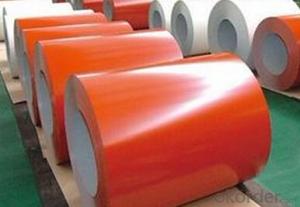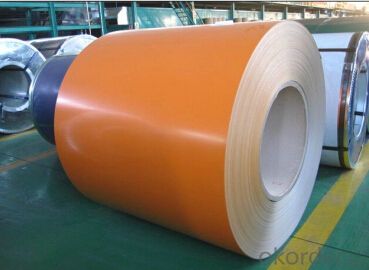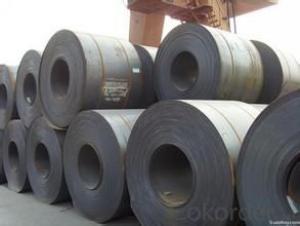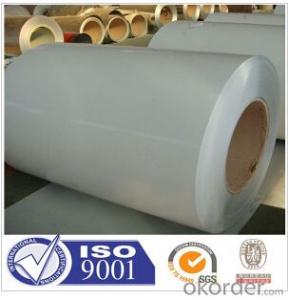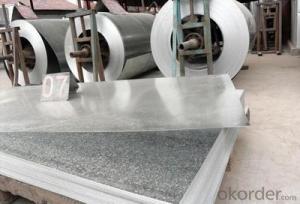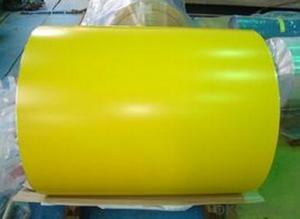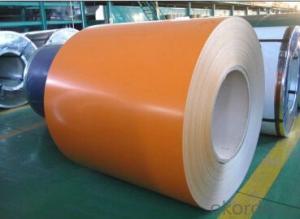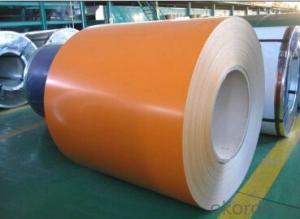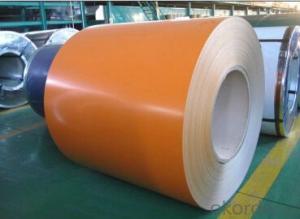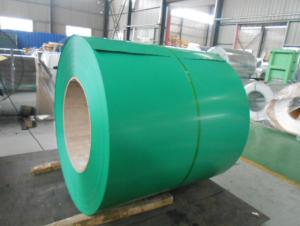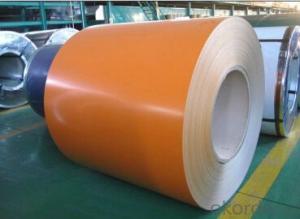Best Prepainted Galvanized steel Coil ASTM 615 -9
- Loading Port:
- Tianjin
- Payment Terms:
- TT or LC
- Min Order Qty:
- 121212 m.t.
- Supply Capability:
- 12121212 m.t./month
OKorder Service Pledge
OKorder Financial Service
You Might Also Like
1.Structure of Prepainted Galvanized steel Coil :
With Gi as base metal,after pretreatmet (degrease and chemical treatment) and liquid dope with several Layers of color,then after firing and cooling,finally the plate steel is called pre-painted galvanized steel ( PPGI) .Pre-painted galvanized steel is good capable of decoration ,molding,corrosion resistance
2.Main Features of Prepainted Galvanized steel Coil:
• Excellent process capability
• Smooth and flat surface
• Workability, durability
• Excellent heat resistance performance
• High strength
• Good formability
• Good visual effect
3.Prepainted Galvanized steel Coil Images
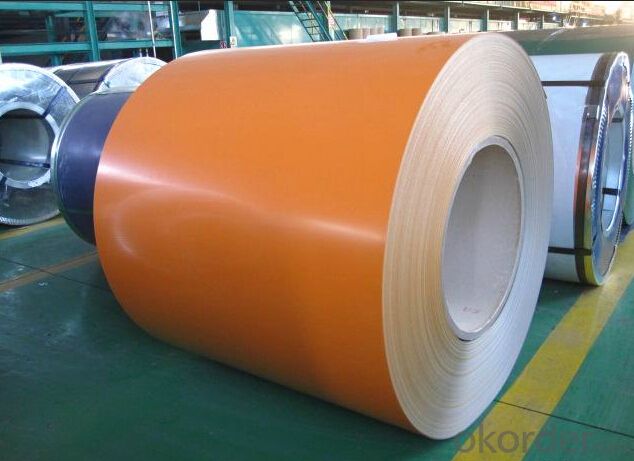
4.Prepainted Galvanized steel Coil Specification
Standard:ASTM, GB,JIS,JIS G3302 ASTM 755 EN10169
Grade: DX51D CGCC CS
Thickness: 0.13mm~3.0mm,
Width: 1250,600-1250mm
Coil weight:3-12 MT
Coil ID:508/610mm
Chemical composition:
C | Si | Mn | Cr | Ni | P | S |
0.150 | 0.476 | 11.231 | 12.50 | 0.900 | 0.039 | 0.010 |
5.FAQ of Prepainted Galvanized steel Coil
We have organized several common questions for our clients,may help you sincerely:
1.How do you control your quality?
We have established the international advanced quality management system,every link from raw material to final product we have strict quality test;We resolutely put an end to unqualified products flowing into the market. At the same time, we will provide necessary follow-up service assurance.
2.how long we will receive the goods?
After receiving your deposit or workable lc ,our normal shipment date is 15-20days,and it takes around 28 days to reach your port of destination. But is up to different destination
3. what is your moq ?
Normally our moq is 25per size ,but it is up to different size
- Q: What is the maximum thickness of steel coils?
- The specific application and manufacturing process play a significant role in the potential range of maximum thickness for steel coils. Typically, steel coils may vary from a few millimeters to several centimeters in their maximum thickness. Determining factors include the intended use of the coils, the type of steel employed, and the capabilities of the manufacturing equipment.
- Q: What is the shelf life of a steel coil?
- The shelf life of a steel coil can vary depending on various factors such as the type of steel, storage conditions, and specific industry requirements. However, in general, if properly stored and protected from moisture, corrosion, and other damaging factors, a steel coil can have a shelf life of several years.
- Q: What are the common size limitations for steel coil production?
- The common size limitations for steel coil production can vary depending on several factors such as the type of steel being used, the manufacturing process, and the equipment available. However, there are some general size limitations that are commonly observed in the industry. One of the primary constraints is the width of the steel coil. The width of the coil is typically limited by the size of the rolling mill or the slitting equipment used for production. Standard widths for steel coil production range from around 600 millimeters (23.6 inches) to 2,000 millimeters (78.7 inches). However, widths outside of this range can also be achieved through specialized equipment and processes. Another limitation is the thickness of the steel coil. This can be influenced by the type of steel, the intended application, and the manufacturing capabilities. Common thicknesses for steel coils range from 0.15 millimeters (0.006 inches) to 6 millimeters (0.236 inches). Thicker or thinner coils can be produced, but they may require specialized equipment and processes. The weight of the steel coil is another important consideration. The maximum weight of a steel coil is typically determined by the capacity of the production and handling equipment, as well as transportation limitations. Standard coil weights range from a few hundred kilograms to several tons. However, it is possible to produce coils that exceed these limits by using larger equipment or dividing the coil into multiple smaller coils. In addition to width, thickness, and weight, there may also be limitations on the length of the steel coil. This can be influenced by factors such as the size of the production line, the handling and transportation capabilities, and customer requirements. Standard coil lengths typically range from a few meters to several tens of meters. However, longer coils can also be produced by using specialized equipment and processes. It is important to note that these size limitations are not fixed and can vary depending on the specific requirements of a project or customer. Manufacturers often work closely with customers to determine the optimal size limitations for their steel coil production, ensuring that the final product meets the desired specifications.
- Q: If rail ties were melted, would they be like any other type of steel?
- As so much about the railroad is variable, so is the steel used for the rail. For one thing, all rail is not the same size. It is classified by weight per yard. For example, most tangent (straight) track is 139 lbs rail, meaning three feet of it weighs this much. Secondary track, such as found on branch lines and in yards or used on sidings is not as heavy. Track used in curvature may be the same weight, but not always. The reason is there is much more stress imparted to the roadbed in curvature. Most steel on main tracks has a higher carbon content, but there is a point of diminishing returns, as this rail is more brittle as a result. Good luck trying to melt it. In the field, this rail is cut by a saw with diamond studded circular blades. The reason why is it takes a lot more time to try to cut it with an acetylene torch. In the US, certain areas, such as on some bridges, the cross-ties (sleepers) are indeed made of steel, in addition to concrete and wood. The potential for fire is too great for wood in these instances. In addition, if even a single wheel derails, concrete ties tend to explode when stressed this way. All of which makes steel cross-ties worth the extra cost.
- Q: What are the different methods of coil blanking for irregular shapes?
- There are various methods of coil blanking for irregular shapes, including laser cutting, waterjet cutting, and die cutting. Laser cutting involves using a high-powered laser beam to cut through the coil material, providing precise and intricate cuts. Waterjet cutting uses a high-pressure stream of water mixed with abrasive material to cut through the coil, offering flexibility and accuracy. Die cutting utilizes a custom-made die to stamp out the desired shape from the coil material, ensuring uniformity and efficiency. Each method has its own advantages and suitability depending on the specific requirements of the irregular shape being blanked.
- Q: How are steel coils unloaded from a truck?
- Steel coils are typically unloaded from a truck using specific equipment and a well-coordinated process. The unloading process involves several steps to ensure the safe and efficient removal of the steel coils. Firstly, a forklift or crane is typically used to reach inside the truck bed and secure the steel coil. The forklift or crane operator carefully positions the lifting apparatus underneath the coil, ensuring that it is centered and balanced. Once the steel coil is properly secured, the forklift or crane slowly lifts it out of the truck bed while maintaining stability. The operator must be cautious and consider factors such as the weight and dimensions of the coil to prevent any accidents or damage. After the steel coil is lifted out of the truck, it is usually placed onto a designated area such as a flatbed trailer, storage rack, or directly onto the ground. If placed on the ground, protective measures such as wooden blocks or rubber mats are often used to prevent any damage to the coil or the surface it is placed on. In some cases, steel coils may be unloaded using a specialized coil trailer, which is equipped with hydraulic systems to tilt the trailer bed and roll the coil off. This method is particularly useful for unloading larger and heavier coils. Overall, unloading steel coils from a truck requires skilled operators, appropriate lifting equipment, and adherence to safety protocols. It is essential to follow these steps meticulously to ensure the safe and efficient unloading of steel coils.
- Q: What are the different coil slitting line configurations used for steel coils?
- There are several different coil slitting line configurations used for steel coils, including the looping pit slitting line, the looping tower slitting line, the non-looping slitting line, and the traveling head slitting line. Each configuration offers unique advantages and is suited for specific applications and production requirements.
- Q: Can steel coils be stored in a corrosive environment?
- Ideally, steel coils should not be stored in a corrosive environment as exposure to corrosive elements can lead to degradation and damage to the steel surface. Corrosion can weaken the structural integrity of the coils and affect their performance. To ensure the longevity and quality of the steel coils, it is best to store them in a dry and non-corrosive environment.
- Q: For my homework we have to fill out a table, but I cannot find some basic uses of these types of steel anywhere:Low carbon steel (iron mixed with lt;0.25% carbon)High carbon steel (iron mixed with lt;1.5% carbon)Stainless steel (iron mixed with nickle an chromium)Titanium steel (iron mixed with titanium)Manganese steel (iron mixed with manganese) Thanks :)
- Low okorder / You say you cannot find there uses anywhere. These all came up using the simplest of web searches. You really need to have a word with your IT teacher as clearly you are not doing basic searches properly.
- Q: For example, (and this is weird) if I were wearing a steel collar and I needed some way to remove it, with limited supplies.Force is difficult because it would be around my neck.Chemical cominations are great- but they have to use VERY common products. And I'm not sure what to use.Other ideas?
- Your best bet would be a grinding wheel attached to a small electric motor. Even if you slipped, your skin is too soft to be cut by the dull wheel. Steel, however, is easily cut. But perhaps you don't have access to electricity or pressurized air to run such a tool. In that case, a simple file would work well, though you'd be somewhat more likely to injure yourself. If you had no tools, but access to whatever chemicals you wanted, you could try a weak acid. This would take a long time, and require constant scrubbing to bring fresh acid into the pits in the metal, but it would eventually eat through the collar.
Send your message to us
Best Prepainted Galvanized steel Coil ASTM 615 -9
- Loading Port:
- Tianjin
- Payment Terms:
- TT or LC
- Min Order Qty:
- 121212 m.t.
- Supply Capability:
- 12121212 m.t./month
OKorder Service Pledge
OKorder Financial Service
Similar products
Hot products
Hot Searches
Related keywords
